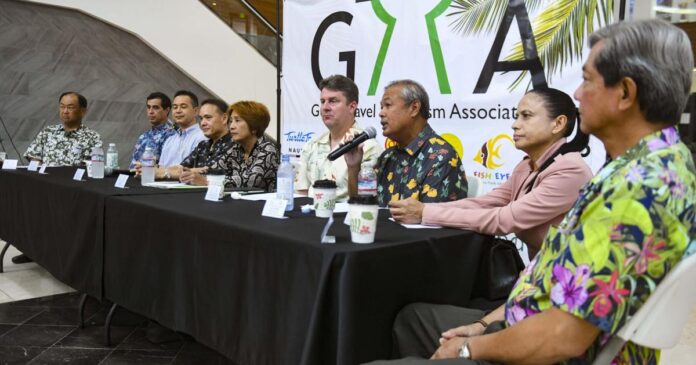Amid optimism about a tourism comeback, many of Guam’s businesses are still struggling to stay open and keep their workers employed while also facing significantly higher costs of power and shipping.
They seek more government help, specifically by launching a second round of the Local Employers Assistance Program, or LEAP 2.
‘Difficult time’
“In my personal view, this is the most difficult time we have experienced during the last 30 months since the pandemic began. We are seeing rapidly rising costs all over the island,” said Richard Hart, president and chief executive officer at Apple Pacific Restaurant Group, which operates Olive Garden, Applebee’s, IHOP, Pieology Pizzeria and LongHorn Steakhouse.
David Tydingco, Valley of the Latte Adventure Park managing director and CEO, addresses members of the local media as he and other Guam Travel & Tourism Association directors hold a press conference at the Tumon Sands Plaza on May 24, 2022. Several Guam businesses, along with visitor industry stakeholders and organizations, are calling for a second round of Local Employers Assistance Program funding.
Shipping costs have gone up by nearly 40%, power bills increased by nearly 35% since June and the cost of food continues to climb to ‘unreal levels,’” Hart said.
“All these things combined make it a very challenging environment for any business to survive, let alone thrive,” he added. “On top of all that, tourism is very slow to return.”
David Tydingco, co-founder of the Guam Travel & Tourism Association and managing director at Valley of the Latte Adventure Park, on Monday said the first round of LEAP tremendously “helped people” keep their jobs and allowed businesses to continue providing services — but “challenges” remain.
“LEAP 2 would be necessary but it should also come up with a plan,” he said, citing a still slow tourism recovery, about a 40% increase in utilities and other costs, and the negative impacts of the diminished power of the Japanese yen and Korean won.
“We see the light at the end of the tunnel because the Korean market has started to come back but there’s still that gap that needs to be filled. We don’t anticipate both the Korean and Japanese markets to have significant arrivals until December to January,” Tydingco added.
The summer months saw an uptick in visitor arrivals, only to slow down again starting in August, businesses said.
‘Still struggling’
“We still have local-owned and operated retailers, optional tours, restaurants and hotels that are still struggling due to the slow return of tourist arrivals from Japan and Korea,” said Monte Mesa, also a co-founder of GTTA and the general manager of Guam Premier Outlets and Tumon Sands Plaza.
Gov. Lou Leon Guerrero, as of Monday, had yet to say whether she’s considering allocating more funds for a second round of LEAP.
There’s still some $292 million in allocated but unspent American Rescue Plan funding the governor could tap to respond to pandemic relief and recovery needs, as of Sept. 30.

Two-year-old Samuel Paulino covers his ear to muffle the sound of an idling Lam Lam Tours’ Red Guahan Shuttle as his mother pays for their passage aboard the bus outside the Guam Premier Outlets in Tamuning on Sept. 12, 2022. Several Guam businesses, along with visitor industry stakeholders and organizations, are calling for a second round of Local Employers Assistance Program funding.
$62M for 1,000 businesses
LEAP provided nearly 1,000 pandemic-hit businesses with some $62 million in direct financial aid.
Of that amount, $25 million came from legislative appropriations while the rest came from ARP money.
LEAP money went to a wide range of businesses, from taxi operators to hotels, restaurants, auto repair shops, retail stores, beauty salons and tourist attractions.
The amount of LEAP awards ranged from about $2,000 to $300,000. But more help is still needed, considering how the pandemic upended the tourism economy, businesses said.
“Local businesses need help keeping people employed and to survive for when things get better and the overall business climate has improved for everyone, not just businesses,” Hart said.
Businesses, he said, can’t just pass on the highest costs of power and shipping to customers “or they will just stop coming out to eat.”
“When people stop coming out, our team members suffer with reduced hours and lack of income. All businesses on Guam are connected economically. If one industry suffers, it is only a matter of time before they all do. It trickles down very quickly,” Hart said.
The first round of LEAP, Hart said, helped their restaurants keep more than 250 team members employed for the last nine months, and helped to keep operations going.
“Without it, some of the businesses would have certainly survived, but it would have been with less people — meaning we would have had to furlough a large number of team members and then try and rehire them when things improve,” he said.
Tourism forum
Tydingco said the 2022 Tourism Forum that GTTA and the Guam Hotel and Restaurant Association will co-host Oct. 18 will have a presentation on the role of LEAP in maintaining Guam’s tourism industry.
The forum is set for 9-11 a.m. at the RIHGA Royal Laguna Guam Resort.
Mesa said the University of Guam and the Guam Economic Development Authority conducted a survey of companies that had received help under LEAP and the survey results will be released soon.
“These results will hopefully show where the needs are for LEAP 2 funding,” he said.
Officials cut the ribbon at the new Westin Club Lounge at The Westin Resort Guam.
Guam Visitors Bureau Vice President Gerry Perez, at a bureau forum, said GVB supports a second round of LEAP for businesses, citing the need to sustain the value chain of delivering a Guam destination experience.
GVB also advocated for and supported the first round of LEAP, which helped hundreds of tourism-related businesses.
Should GovGuam consider a LEAP 2, Mesa said the GEDA qualifications criteria for using gross receipts tax reported in 2022 compared to the same period in 2019 “can still be used to see how much some businesses need support to allow them to survive until our tourist visitors return to normal monthly arrival numbers.”










